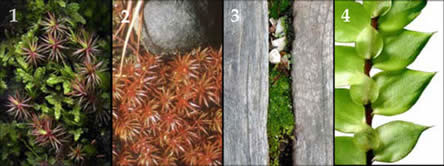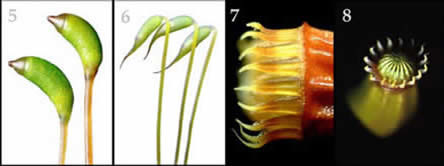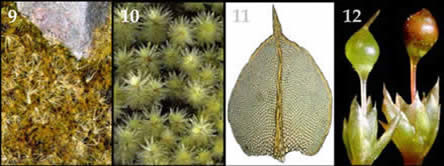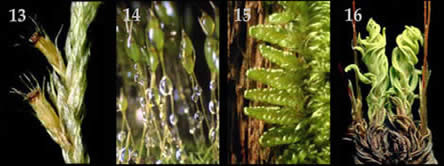Mosses, like the other bryophytes (liverworts and hornworts), are an ancient group of simple plants dating back some 360 million years. They represent an evolutionary step up from algae, the simplest plants in the Plant Kingdom. After vascular plants, mosses are the most diverse group of plants, consisting of over 10,000 species in about 850 genera. Over 500 species in 200 genera are found in New Zealand.
In the life cycle of bryophytes, a sexually-reproducing gametophyte generation alternates with a spore-producing sporophyte generation. The plant that is conspicuous in the field as a moss is the gametophyte. Fertilisation of the moss gametophyte egg gives rise to a cell, the zygote, which grows into a sporophyte attached to, and partially parasitic on, the gametophyte. The sporophyte is, in most mosses, a short erect stalk or seta bearing a single terminal capsule in which spores, usually in great numbers, are produced. The typical sporophyte has some photosynthetic tissue and an intricate system of teeth at the mouth of the capsule to regulate spore release into the air. These features are quite different from those of liverwort sporophytes. Spores that establish on suitable substrates can develop into new gametophytes. Mosses can also spread via asexual or vegetative reproduction, from small pieces of stem or individual leaves. Some mosses produce on the gametophyte specialised structures for asexual reproduction called brood bodies, which can take on many different forms depending on the species, and are helpful for identification.
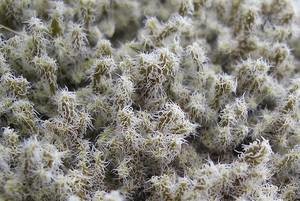 Some mosses, such as Racomitrium lanuginosum, are able to tolerate periodic drying out. Photo: Jesse BythellMoss gametophytes lack the woody tissue of vascular plants and have, in place of roots, a system of filamentous rhizoids that serve primarily for attachment. The leaves are mostly one cell thick and are arranged in spirals about the stem axis. They are usually pointed, rather than lobed, and often have a conspicuous nerve, features that further assist in distinguishing mosses from other bryophytes. The stems of many short-lived mosses are erect and terminate with sex organs and sporophytes. Other, more long-lived mosses have an extensive prostrate, branching growth form on which sporophytes are periodically produced.
Some mosses, such as Racomitrium lanuginosum, are able to tolerate periodic drying out. Photo: Jesse BythellMoss gametophytes lack the woody tissue of vascular plants and have, in place of roots, a system of filamentous rhizoids that serve primarily for attachment. The leaves are mostly one cell thick and are arranged in spirals about the stem axis. They are usually pointed, rather than lobed, and often have a conspicuous nerve, features that further assist in distinguishing mosses from other bryophytes. The stems of many short-lived mosses are erect and terminate with sex organs and sporophytes. Other, more long-lived mosses have an extensive prostrate, branching growth form on which sporophytes are periodically produced.
Mosses are dependent on available surface water for metabolism and for reproduction. Water and solutes are absorbed directly through leaf surfaces, and a surface water film is required for male gametes to swim to fertilize eggs. Mosses are, thus, conspicuous in damp environments. In New Zealand, they are found in lakes, attached to rocks in fresh water streams, are present on soil and rocks on stream banks and on the forest floor, and grow abundantly on fallen logs and as epiphytes on tree bases, trunks, branches and twigs. They are most evident along with liverworts in montane cloud forests where transpiration is low and water can be absorbed from mist droplets. They are also present, however, in a wide range of more arid terrestrial environments, from coastal spray zones to alpine rocks. The ability of some mosses to occupy more arid environments stems from their remarkable ability to withstand long periods of desiccation and return to full metabolism when water again becomes available. Tolerance of desiccation and low temperatures enables some mosses to survive even in Antarctica.
Mosses vary in size from 1 metre mats and cushions down to less then 1 mm. The flora includes Dawsonia superba and Dendroligotrichum dendroides that stand nearly 40 cm high. Umbrella form forest mosses are also common.
About 20% are endemics. The main affinities are primarily with Australia and, to a lesser extent, with South America.
Information on New Zealand mosses
- New Zealand Mosses: An Illustrated Key by Bill and Nancy Malcolm and Jim Shevock (version xii 2020) (PDF, 47.54 MB)
- Auckland University moss information *
For more information about mosses see
* The Network is not responsible for the content of external websites.
Some New Zealand Moss images (by Bill Malcolm)
1. Polytrichum juniperinum, a hair-cap moss, and Hypnum cupressiforme, a feather moss
2. Polytrichum juniperinum, reddish sun-form
3. Bryum argenteum in crack of boardwalk, urban moss
4. Cyathophorum bulbosum shoot, gametophyte (leafy shoot) generation
5. Warnstorfia fluitans capsules, sporophyte (spore capsule) generation
6. Plagiomnium novaezelandiae capsules, sporophyte (spore capsule) generation
7. Hypnum comatum capsule teeth
8. Ptychomnion aciculare capsule teeth
9. Campylopus clavatus brood bodies
10. Pulchrinodus inflatus spiral leaves
11. Hypopterygium sp. leaf nerve (midrib or vein)
12. Physcomitrium pyriforme stems, young capsules at stem tips
13. Cryphaea tenella stem, mature capsules on stem branches
14. Ceratodon purpureus dew-wetted capsules and stalks
15. Hypnum chrysogaster epiphytic moss (on tree-bark)
16. Barbula calycina desiccated but still-living shoots
